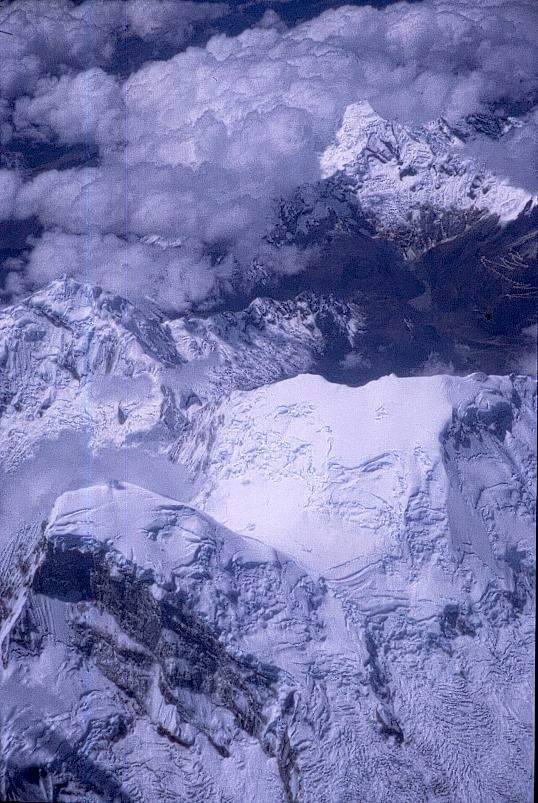 Huascarán, Perú |
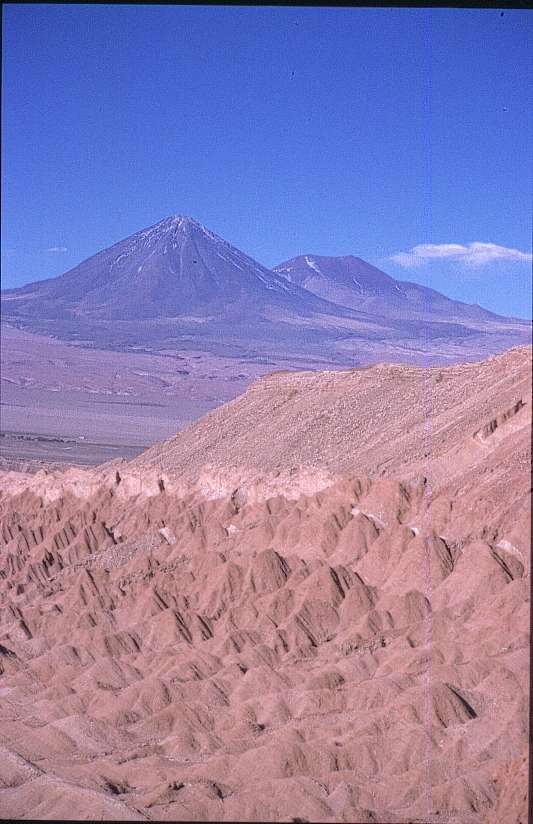 Licancabur, Chile |
 Illimani, Bolivia |
Back to the home page
On 11 july 2005, Pluton's satellite Charon will occult the star 2UCAC 2625 7135. This event was first announced by Dave Herald, using the Winoccult software. It has also been added in September 2004 in the MIT list , under the reference "C313.2". This event could be visible from Perú, Bolivia, Paraguay, Brazil, Urugay, Argentina and Chile around ~ 03:35-03:40 UT, depending on the site.
The page below provides some basic information on this event. It is preliminary and will be updated as improvements are avaible, especially concerning the predictions. (Remember that Charon is only 0.055 arcsec across on the sky!).
Complementary information (finding chart, weather statistics, etc...) is provided in the IOTA/ES site
 Huascarán, Perú |
 Licancabur, Chile |
 Illimani, Bolivia |

|
The main goals for observing this event are: (1) measure Charon's diameter, and then derive its mean density (with also indirect consequences for Pluto's diameter and density) and (2) detect or put a stringent upper limit for an atmosphere of the satellite.
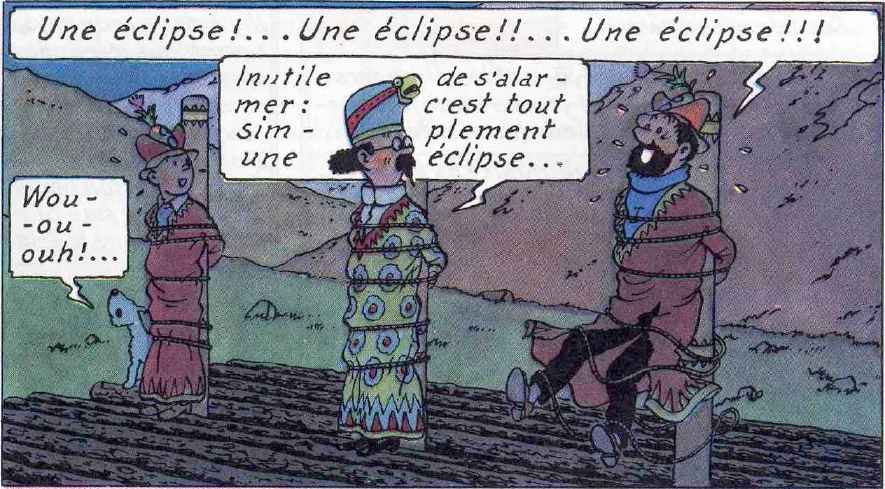
|
Star position: as of September 2004 -
Combining the 2UCAC position of the star, and FASTT measurements by R. Stone at Flagstaff,
the ICRS J2000 position of the star at epoch 11 July 2005 (taking into account proper motion)
is expected to be:
17 h 28 mn 55.0130 sec
-15 d 00' 54".719
with typical uncertainties of 30 mas.
Pluto ephemeris: update March 2005 -
Recent improvements in the Pluton/Charon system ephemeris by M. Standish (see the JPL
"Horizon" ephemeris available since March 2005)
now provides the DE413/Plu013 ephemeris, with the following corrections with respect to the previous
DE405 ephemeris:
Δα cos(δ)= -84 mas
Δδ= -38 mas
with typical uncertainties of 20 mas.
Star position: update June 2005 -
Measurements made at the IAGUSP 60cm telescope of Pico dos Dias (Brazil) on 2-4 April 2005 provide the following
position for the star. The reductions and analyses were made by M. Assafim, A.H. Andrei and D.N. da Silva Neto.
Note: this position has been measured using 2UCAC star positions, and then applying a catalog
correction to go from 2UCAC positions to ICRF positions. In this manner, the star position is consistent
with the JPL online ephemeris of Pluto, also given in the ICRF system.:
α= 17 h 28 mn 55.0167 sec
δ= -15 d 00' 54".726
with typical uncertainties of 11 mas.
Furthermore, images taken in April 2005 with the NACO adaptive optics camera at VLT/Paranal (ESO) does not reveal any close companion of the star, see section "imaging" below.
Charon ephemeris: update June 2005 - VLT/NACO adaptative images of Charon and Pluto have been made on 9 June 2005 around 05:00 UT. At this time, the orbital phase of Charon was the same as for the 11 July 2005 occultation (around 03:40 UT). In this manner, any offset in the orbital motion of Charon around Pluton can be directly implemented for the occultation time. In total, 45 individual measurements were obtained from about 04:50 to 05:40 UT, 9 June 2005 (reductions by Eric Gendron), with sub-mas internal accuracy. Pixel size and orientation were derived from NACO images of 2UCAC 2625 7135 (alias C313.2) and its neighbor 2UCAC 2625 7163, 14.3 arcsec away at position angle 117 deg.
 |
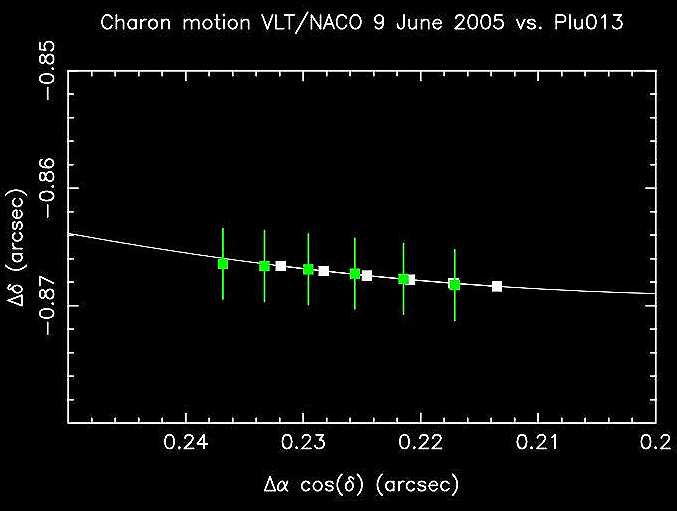 |
Left: the 45 NACO Charon positions relative to Pluto (the latter located at x=0 and y=0), in r.a. and dec. J2000, on 9 June 2005 between 04:50 and 05:40 TU. White curve: expected motion of Charon from the PLU013 Horizon ephemeris ( "Horizon" ). The white squares show the expected Charon positions at 04:50; 05:00, 05:10, 05:20, 05:30, 05:40 UT, from left to right. Right: the same as left panel, with the green squares showing the NACO Charon positions, after grouping and averaging of the 45 positions shown in left panel, at 04:50; 05:00, 05:10, 05:20, 05:30, 05:40 UT. The vertical error bars (+/- 3 mas) comes essentially from the uncertainty in pixel size (13.32 +/- 0.05 mas). The horizontal error bars (not shown) are of the order of 1 mas.
Note the systematic offset of about 4 mas between the observed and calculated positions, Charon lagging along its orbit by about 0.4 deg in longitude. Note also, however, that this offset could entirely be caused by (unknown) displacements of Pluton and/or Charon's photocenters, due to albedo features on both bodies. For comparison, the offset between Pluto's photocenter and physical center was about 8 mas during the 20 July 2002 occultation, after analysis of NACO images taken on that night, compared with the timing of the event at Mamiña (Marc Buie) ans Arica (François Colas).
Consequently, no significant offset between NACO observations and PLU013 are beeing detected, to within a limit of ~ 5 mas.
Predictions: update 18 June 2005 - Accounting for the various updates presented above, the resulting prediction is shown below, where the darker band is the nominal prediction based on the Pluto/Charon DE413/PLU013 ephemeris and the star position from Pico dos Dias. The dots in the central line are plotted every minute, and Charon minimum diameter is assumed to be 1200 km. Under this assumption, the event (if central) will last a little bit less than one minute. The lighter grey band delimited by dotted lines is the region of uncertainty where the occultation could take place. This assumes an overall uncertainty of ~ 22 mas for the event, which combines the current uncertainties on the star position and Pluto's ephemeris.
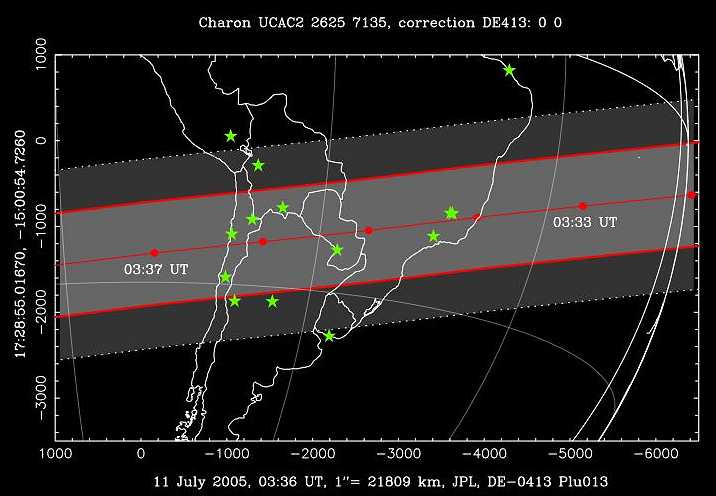
Note: this prediction does not account for possible systematic errors caused by an error in Charon's ephemeris with respect to Pluto, a possible stellar companion of the occulted star, etc... Stay tuned for updates!!!
Taking the prediction above, we obtain the various trajectories of the star relative to Charon, as seen from
different stations:
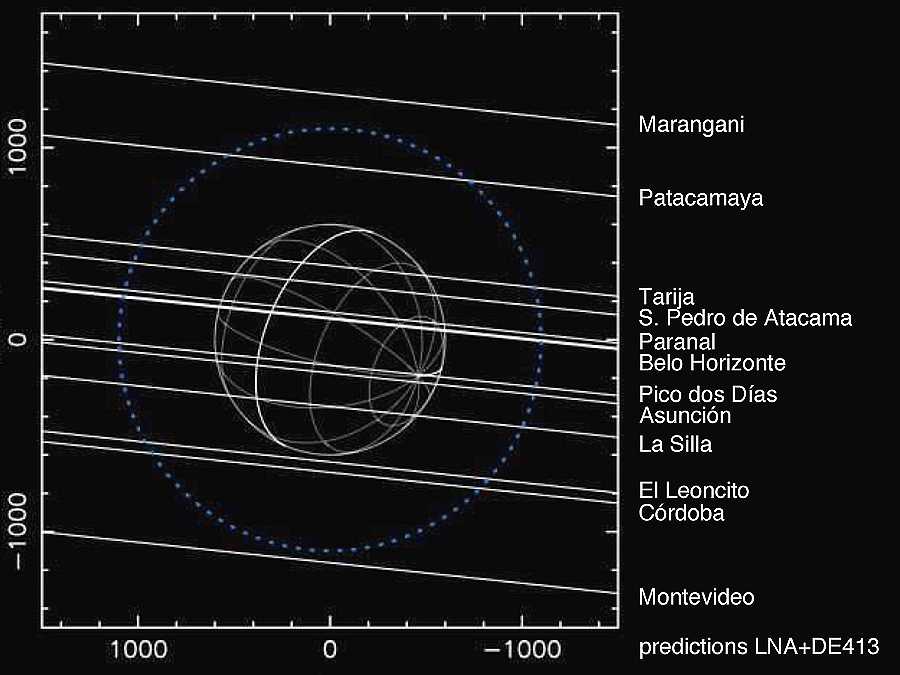
NB. the dotted circle in the figure above gives the typical error domain, where the occultation could take place.
Predictions: update 8 July 2005 - Offset of the Pluto/Charon system has been extracted from the Picos dos Dias data, indicating a 0.012 arcsec offset of Pluto/charon to the north. This yields a corresponding 260 km shift of the shadow to the north, see figure below. The various trajectories of the star relative to Charon (shown in the figure above) should also be shifted 260 km north.
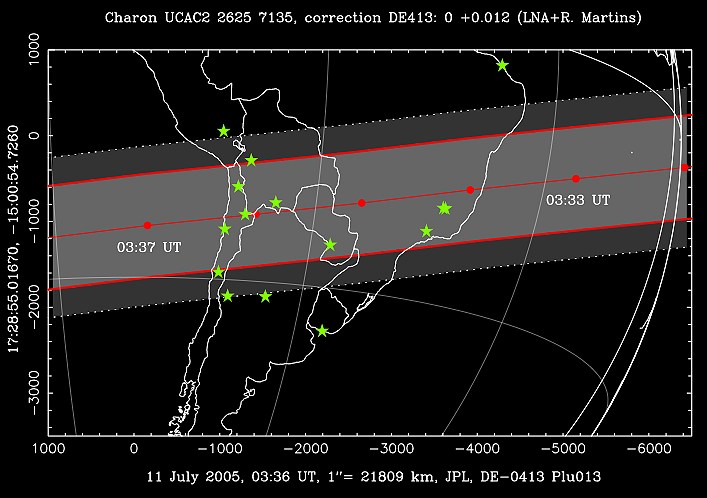
Images of the occulted star have been taken in April 2005 with the 8.2-m VLT adaptive optics camera "NACO". These images are shown below in J, H, K (from left to right). The axes are graduated in arcsec, and the brightness levels are coded in square root of intensity, instead of being linear in intensity.
No companion with brightness larger than 1/500 (Δm= 6.7) that of the occulted star is detected beyond 50 mas of the star, to within a 3-σ noise level. The NACO photometry of the star agrees to about 0.1 magnitude with the 2MASS magnitudes, namely J= 12.9, H= 12.3, K=12.2.
 |
 |
 |
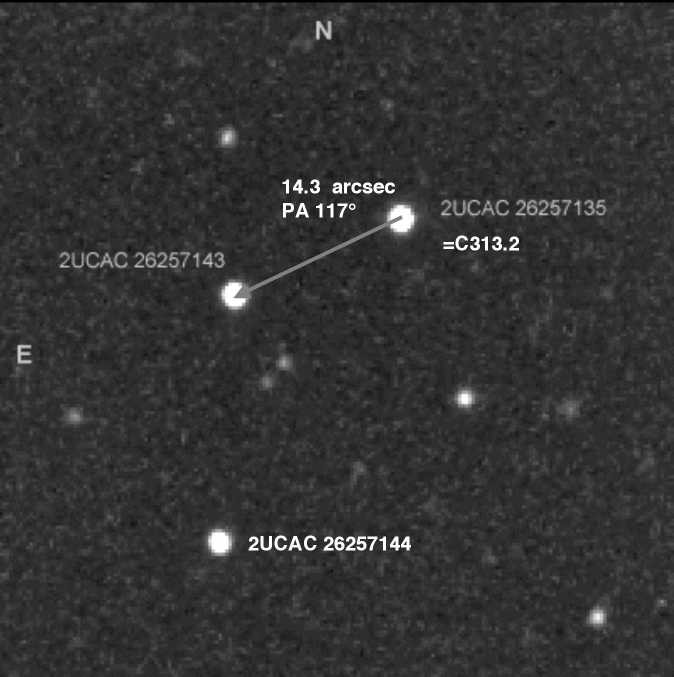 |
Star photometry: update 18 June 2005 - Photometry of 2UCAC 2625 7135 (C313.2), its neighbor 2UCAC 2625 7163 (distance 14.3 arcsec, PA 117 deg), and a third star (2UCAC 2625 7144, 19 arcsec S of 2UCAC 2625 7163) has been obtained by Philippe Rousselot in May 2005, using the ESO 3.55-m NTT telescope at La Silla:
| B | V | R | I | |
| 2UCAC 2625 7135= C313.2 | 16,52 | 15,29 | 14,56 | 13,88 |
| 2UCAC 2625 7163 | 16,98 | 15,64 | 14,84 | 14,08 |
| 2UCAC 2625 7144 | 17,66 | 16,22 | 15,37 | 14,59 |
NB. Browsing on the net (Vizier) indicates the following magnitudes for the star as from various catalogs (USNO, GSC):
R= 14.8, I= 14.2, J= 12.9, H= 12.3, K=12.2. Thus the star appears slightly brighter than expected in R and I, after the table
shown above.
For comparison, Pluto/Charon have V~ 14.1, R~ 13.5, I~ 13.2, J~ 12.8, H~ 12.6, K~12.9, knowing that a ~ 30% variations associated with Pluto's albedo features are present during the 6.4 day period.
Roughly speaking, Pluto/Charon is thus about:
3.0 times brighter that the star in V
2.7 times brighter that the star in R
1.9 times brighter that the star in I
1.1 times brighter that the star in J
0.8 times brighter that the star in H
0.5 times brighter that the star in K
A recent image of the field (3.2 x 2.3 arcmn) taken recently at the NTT ESO/La Silla telescope by Philippe Rousselot is available below:
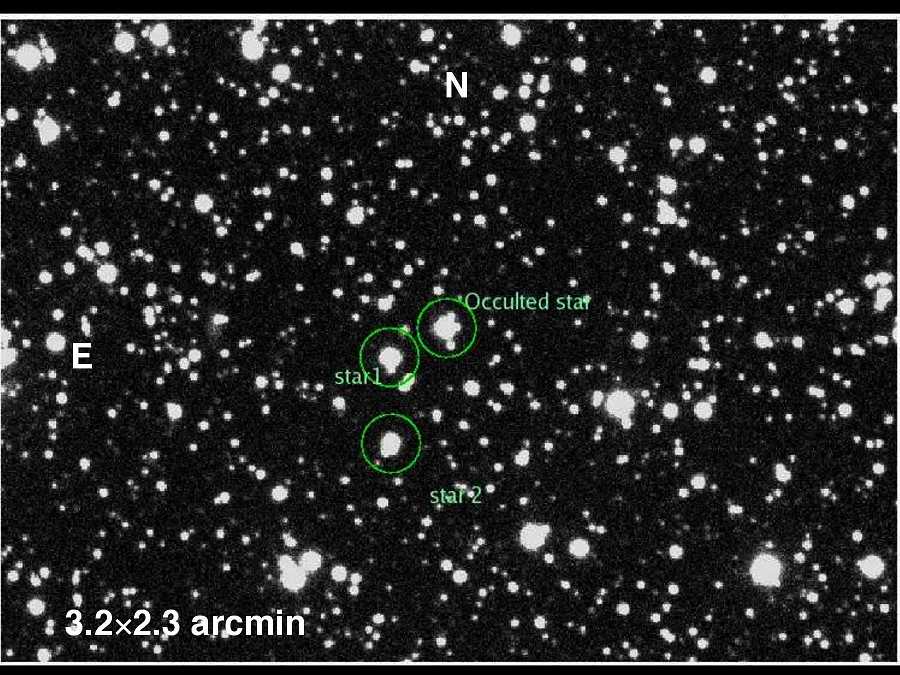 |
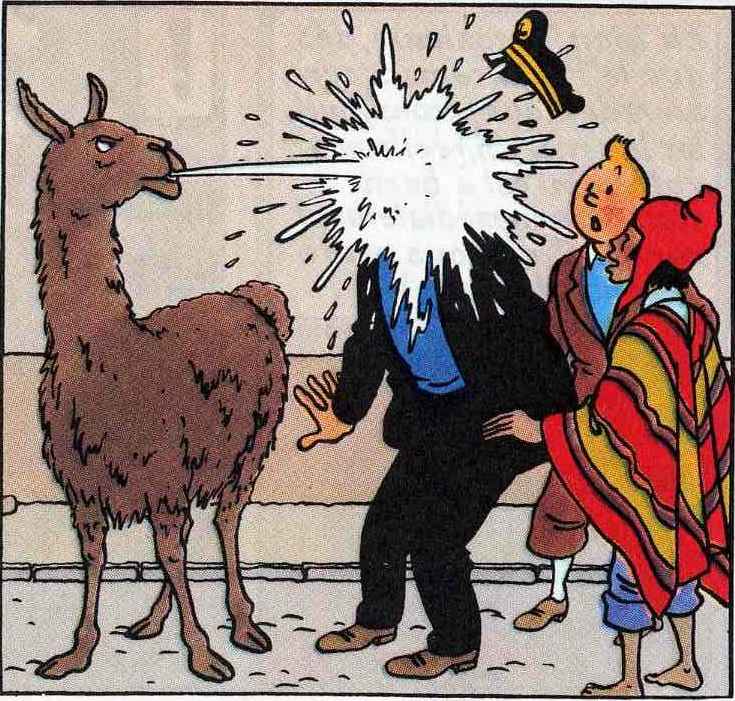 |
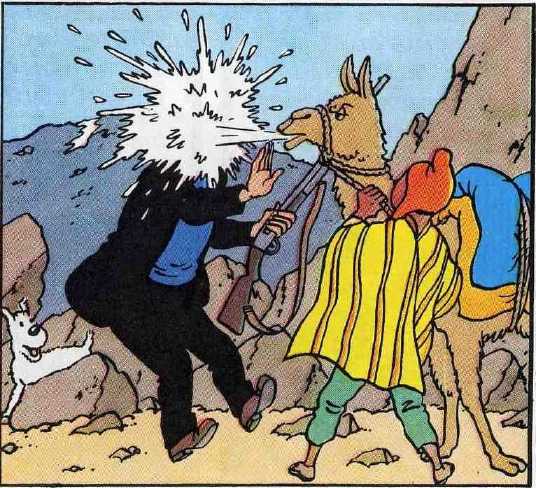 |
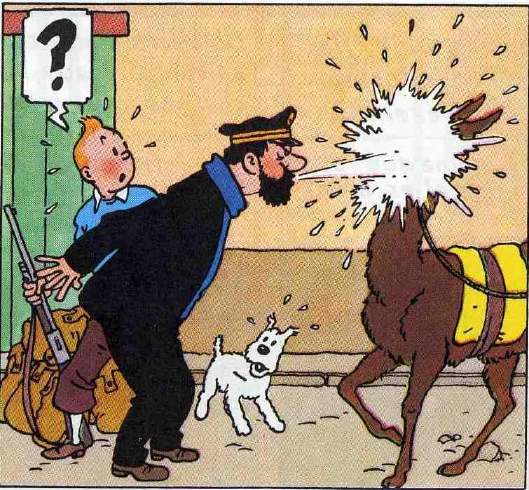 |
 |